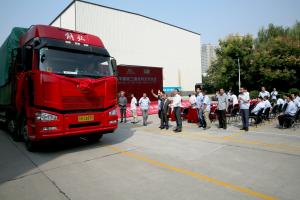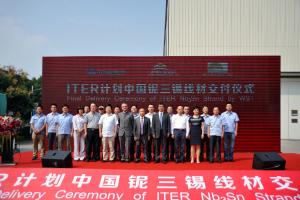China completes niobium-tin strand production
12 Oct 2015
-
ITER China
The final load of superconducting strand left the Chinese manufacturer, WST, on 21 September. As part of a Procurement Arrangement signed with the ITER Organization in 2008, China procured approximately 35 tonnes of Nb3Sn strand for the toroidal field magnet system.
On 21 September, a ceremony was held at Western Superconducting Technologies (WST) in Xi'an, China, to mark the completion of the final batch of niobium-tin (Nb3Sn) superconducting strands for ITER's toroidal field magnet system.
As part of a Procurement Arrangement signed with the ITER Organization in 2008, the Chinese Domestic Agency is responsible for the procurement of approximately 35 tonnes of Nb3Sn strand. The ceremony celebrated the successful completion of this production, which fully complies with ITER requirements and has been accepted by the ITER Central Team. The strands will now be delivered to the cable supplier in China that will produce the rope-type cable at the heart of the ITER cable-in-conduit conductors.
Representatives of the ITER Organization, the Chinese Domestic Agency, local government, and industry were present to witness the departure of the final batch of Nb3Sn strand.
In order to meet the tough technical and quality requirements of the ITER Organization, the Chinese Domestic Agency set up an ISO9001 quality management system and passed on the quality requirements to WST—a supplier with extensive experience in the production of titanium (Ti) components, but that was new to the superconducting wire business. WST improved its quality assurance system and carried out significant R&D efforts before selecting in 2009 a process called "internal tin" for the manufacturing of Nb3Sn wire. A first batch of 500 kgs passed review by the Chinese Domestic Agency and the ITER Organization. WST was awarded the contract for Nb3Sn strand manufacturing in 2009 as the exclusive Chinese supplier.
Celebrating a successful chapter in the industrial effort to build ITER magnets. The completed wire will now be delivered to the cable supplier in China that will produce the rope-type cable at the heart of the ITER cable-in-conduit conductors.
Mass production was in 2011 after successful strand sample tests at SULTAN, carried out according to the terms of the Procurement Arrangement. A total of 822 billets were produced and cleared by the Domestic Agency and the Central Team to be used in the ITER machine. The Nb3Sn strands meet all ITER requirements with high stability.
Thanks to the close collaboration of all parties involved, the Nb3Sn strand production could be completed successfully and on time.
"This is a perfect illustration of what ITER is about," said ITER section leader for Superconductor Systems & Auxiliaries, Arnaud Devred, who attended the ceremony. "Bringing people from all over the world to work together and solve one of the most difficult challenges of our planet: develop a safe, clean and sustainable energy source. Superconductors are no ordinary materials—they require hard work, dedication and craftsmanship and you can all be proud of what you have accomplished. ITER is not only an amazing scientific challenge, but also it is a driver that can promote the development and industrialization of enabling technologies and make our world a better place to be."



